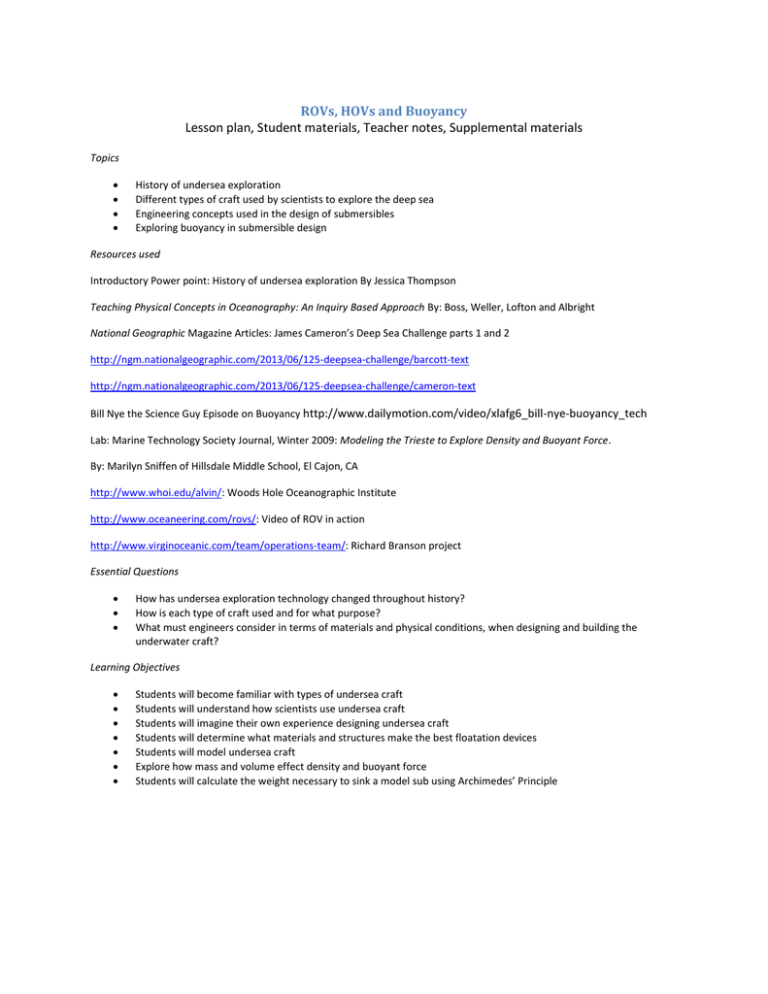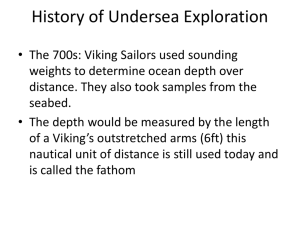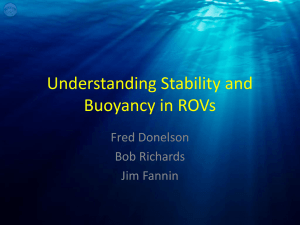unit2_1_LP week 2.docx
advertisement

ROVs, HOVs and Buoyancy Lesson plan, Student materials, Teacher notes, Supplemental materials Topics History of undersea exploration Different types of craft used by scientists to explore the deep sea Engineering concepts used in the design of submersibles Exploring buoyancy in submersible design Resources used Introductory Power point: History of undersea exploration By Jessica Thompson Teaching Physical Concepts in Oceanography: An Inquiry Based Approach By: Boss, Weller, Lofton and Albright National Geographic Magazine Articles: James Cameron’s Deep Sea Challenge parts 1 and 2 http://ngm.nationalgeographic.com/2013/06/125-deepsea-challenge/barcott-text http://ngm.nationalgeographic.com/2013/06/125-deepsea-challenge/cameron-text Bill Nye the Science Guy Episode on Buoyancy http://www.dailymotion.com/video/xlafg6_bill-nye-buoyancy_tech Lab: Marine Technology Society Journal, Winter 2009: Modeling the Trieste to Explore Density and Buoyant Force. By: Marilyn Sniffen of Hillsdale Middle School, El Cajon, CA http://www.whoi.edu/alvin/: Woods Hole Oceanographic Institute http://www.oceaneering.com/rovs/: Video of ROV in action http://www.virginoceanic.com/team/operations-team/: Richard Branson project Essential Questions How has undersea exploration technology changed throughout history? How is each type of craft used and for what purpose? What must engineers consider in terms of materials and physical conditions, when designing and building the underwater craft? Learning Objectives Students will become familiar with types of undersea craft Students will understand how scientists use undersea craft Students will imagine their own experience designing undersea craft Students will determine what materials and structures make the best floatation devices Students will model undersea craft Explore how mass and volume effect density and buoyant force Students will calculate the weight necessary to sink a model sub using Archimedes’ Principle Grades 9-12 Day 1 (45-50 minutes) Day 2 Notes/ discussion Present power point The History of Undersea Exploration. Be sure to show the videos provided. Discuss the differences in materials used and overall design of the craft. Compare and contrast Piccard’s Trieste with Cameron’s Deepsea Challenger. Show Bill Nye episode on buoyancy. Make a Venn diagram or T chart comparing the Trieste to the Deepsea Challenger Power point “History of Undersea Exploration. “Designing Floats” Activity 3.3 in Teaching Physical Concepts in Oceanography Activity Materials Assessment/ HW Read the National Geographic article Deepsea Challenge Part 1 and answer the post reading questions for HW. http://www.dailymotion.c om/video/xlafg6_bill-nyebuoyancy_tech Web access or taped Bill Nye show. For activity: Containers w/ salt and fresh water, two beakers, small vials, weights, balloons, rubber bands, straws, scale, ruler, grad cylinder Have students read the supplemental handout “Buoyancy and Density” and answer the included reading questions. This will prepare them for the next activity, Modeling the Trieste Day 3(90 min. period or 2-3 45 min.) Refresh the students on the previous lesson and activities on pressure and buoyancy. See the write up in Modeling the Trieste this is a longer exploration. If you choose to have students do the construction, add a 45min. day Exploration: Modeling the Trieste to Explore Density and Buoyant Force. See the write up in Modeling the Trieste Day 4 Post lab conclusion and analysis from student worksheet Read Part 2 of the National Geographic Article and do the narrative writing prompt. (Assign over the weekend for best results) Trieste modeling lab may cross into this day Above timeline adapted for 6-8 Notes/ Discussion Day 1 Day 2 Day 3/4 Show footage from http://explorationnow.org/video to insight some discussion and excitement about the potential discoveries of ROVs Use guide: Introduction to Underwater Vehicles Have students fill in the guide while using the internet to research types of undersea craft Guide students through the supplemental handout “Buoyancy and Density” to make sure they understand these concepts Show pictures of the Trieste and discuss how both positive and negative buoyancy were maintained Activity/ Demos Researching online Print out pictures of each type of craft (AUV, HOV, ROV) Computer lab access or laptops Designing Floats activity Modeling the Trieste See write up: Designing Floats Student success at Designing Floats activity See the write up: Modeling the Trieste Final test: Can the models they designed establish neutral buoyancy? Materials Assessment/ HW Have students do research at home and make a Venn Diagram or T-chart comparing the Trieste to the Deep Sea Challenger

![locandina dottorandi [modalità compatibilità]](http://s2.studylib.net/store/data/005259821_1-9e349e4e3bf89f1cc48d1fe5ca196528-300x300.png)

